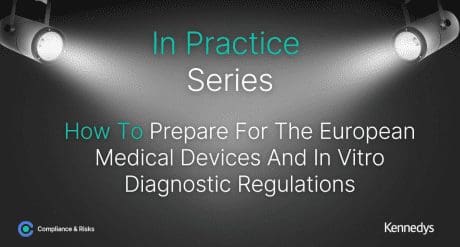
Health Canada Releases Draft Pre-Market Guidance for Machine Learning Medical Devices

AUTHORED BY BENJAMIN FUHRMANN, ASSOCIATE, BLG & EDONA C. VILA, PARTNER, BLG
On Aug. 30, 2023, Health Canada released its anticipated draft guidance document on obtaining authorization for machine learning-enabled medical devices. (machine learning medical devices). This publication seeks to assist manufacturers of class II, III, and IV machine learning medical devices who are submitting applications for, or amendments to, a Medical Device License. The guidance document outlines Health Canada’s expectations for demonstrating the machine learning medical devices’ safety and effectiveness requirements required under s. 10 of the Medical Device Regulations (MDR), and introduces a proposed mechanism for manufacturers to obtain pre-authorization for planned changes to one of its existing machine learning medical devices.
Safety and Effectiveness Requirements
Medical devices that use machine learning technology to accomplish their intended medical purpose are called machine learning medical devices. Machine learning medical devices present challenges to regulators seeking to evaluate the device’s safety and effectiveness because, by their very nature, machine learning medical devices are continually evolving.
The current regulatory scheme addresses safety and effectiveness requirements. Under section 10 of the MDR, the manufacturer of a medical device is required to “take reasonable measures” to identify the risks inherent in the device, reduce or eliminate risks where possible, and provide protection and information appropriate to those risks during the projected useful life of the device.
Key Takeaways from the Draft Guidance:
- Manufacturers should clearly state in a cover letter for all Class II, III, and IV applications that their device uses machine learning. Manufacturers will also want to ensure that there is objective evidence that supports the safety and effectiveness of their machine learning medical device relevant to its intended use. The evidence should also include a description of how the manufacturer has implemented good machine learning practices that remain implemented throughout the machine learning medical device’s product lifecycle. For a summary of these GMLP, please refer to the article on Health Canada’s Guiding Principles on Artificial intelligence and Machine Learning for Medical Devices.
- Manufacturers are encouraged to provide detailed description of the kinds of information Health Canada is seeking in machine learning medical device applications relating to the device’s intended use, indications for use, contraindications, clinical validation, device description, product labelling, risk management strategies, and data selection and management.
- The guidance encourages manufactures to consider providing descriptions of the machine learning development, training, and tuning approaches, system performance testing, and post-market performance monitoring.
- Health Canada’s guidance has also introduced the concept of a Pre-determined Change Control Plan (PCCP) that manufacturers would submit as a standalone section in their MDL application. Through the PCCP, a manufacturer can seek pre-approval for otherwise significant changes in its machine learning medical device’s design and performance that would otherwise require an MDL amendment application.
- The PCCP is proposed to consist of three sections: change description, change protocol, and impact assessment. The PCCP’s change description section invites manufacturers to characterize the machine learning medical device’s baseline design and performance and list anticipated or planned changes across the product’s life cycle (whether by the manufacturer, a user, a patient, or by the device itself). The change protocol section would require manufacturers to describe the set of policies and procedures that control how the planned or anticipated changes will be implemented and managed in a manner that ensures the machine learning medical device’s safety and effectiveness. Depending on the nature of the machine learning medical device and the planned/anticipated changes, the change protocol may need to include the manufacturer’s plans for ongoing data/risk management, modification/update procedures, monitoring, and corrective actions. Finally, the impact assessment section would require manufacturers to outline the potential influence and implications of the changes listed in its PCCP.
Finalization of the Draft Guidance and Opportunity for Industry Feedback
Health Canada is soliciting feedback on its draft guidance from Class II to IV medical device manufacturers, regulatory representatives, and machine learning experts. For example, Health Canada has requested feedback whether it should add or remove any information that manufacturers would be required to provide in PCCP sections. The window to provide Health Canada with input closes Oct. 29, 2023, after which the guidance document will be finalized.
This blog was originally posted on the 18th September 2023. Further regulatory developments may have occurred after publication. To keep up-to-date with the latest compliance news, sign up to our newsletter.
Stay Ahead Of Regulatory Changes
Accelerate your ability to achieve, maintain & expand market access for all products in global markets with C2P – Your key to unlocking market access, trusted by more than 300 of the world’s leading brands.
C2P is an enterprise SaaS platform providing everything you need in one place to achieve your business objectives by proving compliance in over 195 countries. C2P is purpose-built to be tailored to your specific needs with comprehensive capabilities that enable enterprise-wide management of regulations, standards, requirements and evidence.
Add-on packages help accelerate market access through use-case-specific solutions, global regulatory content, a global team of subject matter experts and professional services.
- Accelerate time-to-market for products
- Reduce non-compliance risks that impact your ability to meet business goals and cause reputational damage
- Enable business continuity by digitizing your compliance process and building corporate memory
- Improve efficiency and enable your team to focus on business critical initiatives rather than manual tasks
- Save time with access to Compliance & Risks’ extensive Knowledge Partner network
Stay On Top Of Your Changing Regulatory Obligations
Tell us your compliance challenges and we will find the solution that’s right for you.


